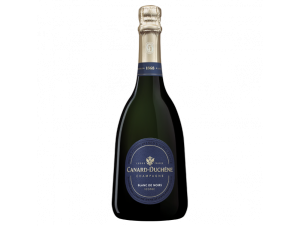You have no items in your shopping cart.
Champagne
Canard-Duchêne
(21 customer reviews)
Canard Duchêne was born just over 150 years ago, in the heart of the Montagne de Reims. The small village of Ludes, where it originated, has preserved not only the charm of yesteryear, but also the know-how handed down from generation to generation, enabling the champagne house to offer a unique wine, strongly marked by the presence of Pinot Noir, which pays homage to its terroir. Find out more
 Recommended by
Recommended byJancis Robinson - Le Guide Hachette - Wine Spectator
-

Shipped in
secured packaging -

Garantie anti-casse :
Prise en charge totale
The winemaker
The story of Victor and Léonie Canard Duchêne
Victor is a tonnelier, Léonie is the daughter of a vigneron. They were born and live in Ludes, in the heart of the terroir champenois and dream of paying homage to their land, located in the heart of the Montagne de Reims. They married and, in 1868, founded the Champagne House that bears their name: Canard Duchêne.
Success was meteoric and quickly spread beyond the borders of France. In 1890, the champagne Canard Duchêne was recognized by Tsar Nicholas II, who imposed it on the Imperial Court of Russia. Since then, the company has been displaying it in its armories. During the First and Second World Wars, the region was hard hit and the Château de Ludes was destroyed. However, the caves cut into the chalk survived, they were able to be fully rehabilitated and they still house the production of the Canard Duchêne house today.
The descendants of Victor and Léonie Canard Duchêne invite you to visit the caves of the château, which were hand-cut in the 19th century. Imagine for a moment the colossal task of digging 6 kilometers of tunnels, spread over four levels, located between 12 and 38 meters deep!
To celebrate the house's centenary in 1968, a uniquely shaped bottle marks the birth of its cuvée prestige: the cuvée Charles VII. Born of meticulous blending, it pays tribute to the terre champenoise and confirms the excellence of the Canard Duchêne house.
Pinot noir, Canard Duchêne's flagship grape variety
The Canard Duchêne style is intimately linked to the pinot noir whose imprint dominates. The village of Ludes lies in the heart of the Montagne de Reims. It dominates the Champagne plain from its plateau, which offers a magnificent view divided between vines on gently sloping hillsides and forests of rare species.
This is where the emblematic pinot noir grape variety grows. It thrives on this Montagne de Reims, whose soil made up of chalk, sand, clay and limestone suits it to perfection. It ripens in the Champagne sun, which encourages it to develop its delicate, fine skin with its intense violet color. The grapes yield a juice that, while colorless, is bursting with delicious aromas. Pinot Noir gives Canard Duchêne champagne all its power and elegance. It lends it its remarkable structure and enriches it profusely with its notes of fruit, most often red: redcurrant, blackberry, strawberry, cherry, raspberry, morello cherry...
The Canard Duchêne tradition of sabrage
The House's signature was once the art of sabrage. This tradition is the legacy of Napoleon's soldiers. It was their custom to open their champagne bottles by sliding the flat of their saber along the neck of the bottle. Sabering is a symbol of victory and the joy of sharing happy times. That's why it's embodied on the Canard Duchêne coat of arms, displaying the iconic saber alongside the crowned double-headed eagle of the Imperial House of Russia.
Eager to perpetuate this tradition, the Maison Canard-Duchêne invites you to come and learn the art of sabering in the heart of its century-old park. Take the opportunity to visit the cellars and admire the unique view of the Montagne de Reims.
Canard Duchêne champagnes
Canard Duchêne Brut
Canard Duchêne Champagne Brut is the fruit of a blend of 60 different crus. It perfectly represents the innumerable qualities of Pinots. Its nose is intense, exuding intense aromas of fresh fruit that you'll long remember. Its color is straw yellow, and the Brut produces a fine, delicate mousse. Its palate delights with fruit notes, mingled with brioche flavors.The Brut is perfect as an aperitif, but will also delightfully accompany your entire meal. It loves terrines, spring dishes featuring early vegetables, and scallops a la plancha. The Brut is composed of a blend where pinot noir and pinot meunier dominate with 40% each, with chardonnay rounding out the remaining 20%.
Canard Duchêne Brut Rosé
Canard Duchêne in its rosé version is the ally of your dinners, on the terrace, at the table or around a buffet. It's ideal for summer evenings, when it's the perfect accompaniment to thinly sliced Serrano ham or white meat seared à la plancha. Of course, it's also perfect as an aperitif. Its nose is very fruity, with intense aromas of fresh fruit, giving pride of place to strawberry and raspberry.Red berries carry through to the palate, lifted by fine spicy aromas.For the Canard Duchêne Brut Rosé blend, pinot meunier takes precedence over pinot noir, with proportions of 40% and 30% respectively. This leaves 30% for Chardonnay.
Canard Duchêne Réserve
Cuvée Canard Duchêne Réserve is prized for the generosity of its aromatic balance. Its nose is subtle, revealing aromas of candied fruit. Its straw-yellow color is soft, and the wine produces a fine, lively mousse. As for its palate, the intensity of its freshness is a delight. Canard Duchêne Réserve is best served as an aperitif, accompanied by a plate of small savory pieces.You can also serve it alongside a grilled quinoa salad, accompanied by burrata and sun-dried tomatoes. Half of the blend is reserved for pinot noir. Pinot Meunier accounts for 30% and Chardonnay for 20%.

6 wines available
between 33 € and 48.9 €
between 33 € and 48.9 €

324 wine's scans
on Twil application
on Twil application
You might like Voir tous les vins de la région
- -32%
- -26%
- -18%
- -22%
























 TWIL - Achat de Vin
TWIL - Achat de Vin


